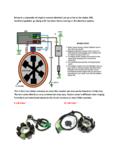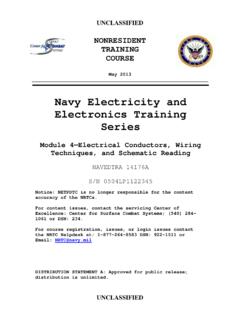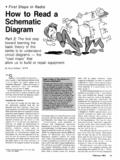Transcription of Surface Science Reports - University of California, San Diego
1 Surface Science Reports 66 (2011) 1 27 Contents lists available atScienceDirectSurface Science Reportsjournal probe force microscopy and its applicationWilhelm Melitza,b, Jian Shena,b, Andrew C. Kummela, Sangyeob Leea, aDepartment of Chemistry and Biochemistry, University of California, San Diego , La, Jolla, CA 92093, USAbMaterials Science & Engineering Program, University of California, San Diego , La, Jolla, CA 92093, USAarticle infoArticle history:Accepted 18 October 2010editor: WeinbergKeywords:Kelvin probe force microscopyScanning probe miscroscopyabstractKelvin probe force microscopy (KPFM) is a tool that enables nanometer-scale imaging of the surfacepotential on a broad range of materials. KPFM measurements require an understanding of both thedetails of the instruments and the physics of the measurements to obtain optimal results. The first partof this review will introduce the principles of KPFM and compare KPFM to other Surface work functionand potential measurement tools, including the Kelvin probe (KP), photoemission spectroscopy (PES),and scanning electron microscopy (SEM) with an electron beam induced current (EBIC) measurementsystem.
2 The concept of local contact potential difference (LCPD), important for understanding atomicresolution KPFM, is discussed. The second part of this review explores three applications of KPFM: metallicnanostructures, semiconductor materials, and electrical devices. 2010 Elsevier All rights 12. Principles of scanning Kelvin probe force Basic principle of atomic force Kelvin probe force Fundamentals of KPFM operational mode: FM and AM KPFM instrumentation and preparation of conducting AFM Comparison of KPFM to other Surface potential measurement High-resolution KPFM: concept of 63. Application of high-resolution Electrical properties of metallic KPFM on metallic Charge transfer in metallic nanostructure Characterization of electrical properties on semiconductor KPFM on semiconductor Adsorbates on semiconductor Nano-scale electrical properties characterization in Quantum Junctions and Solar 234.
3 Concluding 261. IntroductionKelvin probe force microscopy, or KPFM, was introduced as atool to measure the local contact potential difference between a Corresponding author. Tel.: +1 858 534 9505; fax: +1 858 Lee).conducting atomic force microscopy (AFM) tip and the sample,thereby mapping the work function or Surface potential of thesample with high spatial resolution. Since its first introductionby Nonnenmacher et al. in 1991 [1], KPFM has been usedextensively as a unique method to characterize the nano-scaleelectronic/electrical properties of metal/semiconductor surfacesand semiconductor devices. Recently, KPFM has also been used to0167-5729/$ see front matter 2010 Elsevier All rights Melitz et al. / Surface Science Reports 66 (2011) 1 27 Fig. depiction of non-contact AFM operation mode: (a) Amplitude modulation mode and (b) Frequency modulation mode. Both AM and FM modes maintainconstant tip sample separation.
4 AM mode uses oscillation amplitude changes as a feedback signal while FM mode uses frequency changes as feedback the electrical properties of organic materials/devices [2 4]and biological materials [5,6].This review presents the principles and theory of KPFMand explores the use of sub-nanometer resolution KPFM tocharacterize the electrical properties of metal and the KPFM experimental is an AFM based apparatus, thebasic operational principles and instrumentation of AFM and KPFMare reviewed together. A comparison is made between KPFMand other Surface potential or work function measurement Reports show that KPFM can be used to image potentialdistributions on the Surface with sub-nanometer resolution,making KPFM the best technique, at present, for characterizing theelectrical properties of measures a contact potential difference (CPD) betweenthe sample Surface and the tip. In high-resolution KPFM, CPD isstrongly affected by a short-range force between tip and CPD associated with the short-range force is specificallyreferred as the local contact potential difference (LCPD).
5 For thehigh-resolution KPFM, understanding the fundamental differencebetween the CPD and the LCPD is critical, as is knowing how theCPD and LCPD correspond to physical properties of the of KPFM to electrical property analysis of nanos-tructures are reviewed in the second part. (1) KPFM character-ization of the electrical properties of metallic nanostructures isdescribed. KPFM has enabled the experimental determination ofquantumsizeeffectsontheelectronicprope rtiesofmetallicnanos-tructures. (2) KPFM has been used to study of electronic propertiesof semiconductor nanostructures and surfaces . Electronic prop-erties of defects on clean semiconductor surfaces have been in-vestigated using sub-nanometer resolution KPFM. High-resolutionKPFM has been successfully applied to the study of a varietyof adsorbates and their interaction with semiconductor surfaces .(3) High-resolution KPFM has been used to probe semiconductordevices. A notable application of KPFM is the imaging of opera-tional electrical devices to provide the high-resolution potentialprofiles.
6 These measurements provide critical, near-atomic scaleinformation on processing induced defects and their effects to theperformance of the electrical Principles of scanning Kelvin probe force Basic principle of atomic force microscopyKPFM is primarily based on the instrumentation of an AFMsystem. AFM operates in contact, intermediate (tapping), andnon-contact modes. In contact mode operation, the AFM tiptouches the sample Surface , and the tip sample repulsive forcedeflects the tip cantilever. The cantilever deflection is monitoredand used as a feedback signal. In intermediate and non-contactmode, the cantilever is externally oscillated at, or close to, itsresonance frequency. The tip sample interaction is altered asthe tip sample distance changes, leading to a change in oscil-lation amplitude (intermediate mode) and resonance frequency(non-contact mode). These amplitude and frequency changes, withrespect to the reference amplitude and frequency, are used as feed-back signals to obtain the topography of the sample Surface .
7 There-fore, intermediate mode and non-contact mode are referred asamplitude modulation (AM) and frequency modulation (FM) op-eration, intermediate and non-contact mode AFM, the tip sampleinteraction is perturbed by attractive and repulsive forces, causingamplitude or frequency changes in the oscillation of the AFM tip,as illustrated schematically inFig. 1. In AM mode AFM, changes inthe oscillation amplitude provide the feedback signal for seen inFig. 1(a), the amplitude of oscillation increases as thetip sample distance increases, due to the decrease of tip sampleinteraction. The amplitude change is monitored and regulated bya feedback system to keep the tip sample distance constant at apre-determined set-point. The dependence of amplitude changeon the tip sample interaction can be described analytically, basedon the harmonic oscillator model, and the amplitude change isgenerally accepted to be dependent on the force between the tipand sample.
8 Therefore, AM mode measurements represent thedirect force between the tip and sample [7,8].In FM mode AFM, changes in the oscillation frequency pro-vide information about tip sample interactions. The cantileveroscillation frequency changes due to the tip sample distance vari-ation, (b).Afeedbacksystemregulatesthefre-quenc y change to keep the set-point frequency constant, allowingthe topography of the sample Surface to be acquired. The changesin oscillation frequency are dependent on the force gradient be-tween tip and sample when the restoring force of the cantileverthat is associated with tip oscillating energy is large comparedto the interaction force between the tip and sample Surface [8,9].Therefore, the FM mode AFM detects the force gradient rather thanforce itself, a factor enabling FM mode AFM to have higher spatialresolution than AM mode resolution is dependent on the quality factor (Q)ofthe vibrating cantilever, a measure of the energy loss of theoscillation [7].
9 Qis defined as the ratio between resonantfrequency(f0)and frequency change( f)at full-width-half-maximum:Q=f0 f.( )In air, the typicalQof a cantilever, with a resonant frequency of300 kHz, is approximately 100. TheQin ultra-high vacuum (UHV)is approximately 50,000, 500 times theQin air [8]. An expressionfor the minimum detectable force( Fmin)by an AFM is: Fmin= 2kLkBTB 0Q z2osc ,( )wherekLis the force constant of the cantilever,kBTis thethermal energy at the ambient temperature,Bis the measurementbandwidth, 0is the resonant frequency of tip, and z2 OSC is theW. Melitz et al. / Surface Science Reports 66 (2011) 1 273 Fig. diagram of FM mode AFM system operated in UHV. The piezo scannerand the laser/PSD are enclosed in a UHV chamber system. The laser signal isamplifiedthroughthepre-ampandfedintotw ofeedbacksystemsfortheamplitudeand frequency regulation systems. The amplitude is set to a pre-determined set-pointA0. The frequency shift( f)is kept constant to acquire topographic imagesof the sample [9].
10 SincetheQin UHV is 500 times greater thanQin air, the sensitivityof the AFM system can be 20 25 times greater in UHV than , it is desirable to operate the AFM in UHV to achievehigh-resolution. However, it is not desirable to operate AM modeAFM in UHV, since the amplitude change response occurs slowlywith tip sample interaction due to the increasedQin UHV. Thetime scale of amplitude change in AM mode( AM)is given by [9]: AM 2Qf0.( )The time scale of the amplitude change is linearly dependent onQin AM mode AFM. In contrast, the frequency change time responseinFMmode AFMdoesnotdependonQ. Thetimescaleof frequencychange in FM mode( FM)is given by [9]: FM 1f0.( )Therefore, FM mode AFM operated in UHV, with increasedQ,results in high-resolution AFM AFM system is typically composed of tip sample interactionmonitoring (laser and position sensitive detectors) and 2shows the schematic of an FM mode AFMworking in a UHV environment. The amplitude regulation feedbacksystem and the frequency regulation feedback system are thetwo feedback loops in an FM mode AFM system.







